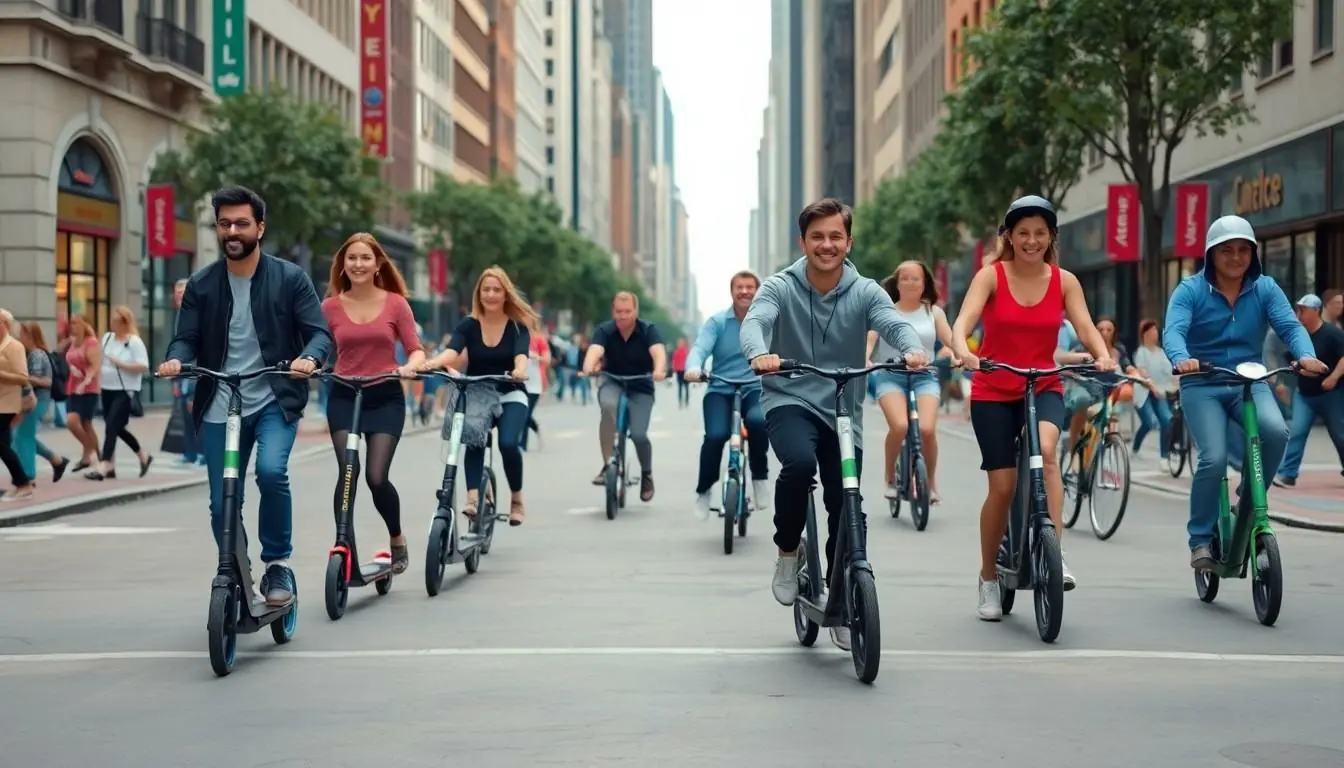In a world where traffic jams and parking woes reign supreme, electric personal transportation vehicles are the superheroes we never knew we needed. Imagine gliding through the streets on a sleek e-scooter or zipping past gridlocked cars on an electric bike. These eco-friendly marvels not only save time but also spare the planet from the clutches of pollution.
Table of Contents
ToggleOverview Of Electric Personal Transportation Vehicles
Electric personal transportation vehicles encompass a variety of options, including e-scooters, electric bikes, and hoverboards. These vehicles enable users to traverse urban environments efficiently. Urban dwellers increasingly rely on these options to address traffic congestion and limited parking availability.
E-scooters are compact and easy to use, often available through rental services in many cities. They allow riders to navigate short distances quickly. Electric bikes, renowned for their versatility, offer features like pedal assist for longer journeys, making them suitable for commuting or leisurely rides. Both options significantly reduce dependence on cars, consequently lowering emissions.
Environmental benefits are substantial, with electric vehicles producing zero tailpipe emissions. By choosing electric over traditional vehicles, users actively contribute to cleaner air and reduced noise pollution. In fact, cities implementing e-scooter and bike-sharing programs report decreases in vehicular traffic and overall congestion levels.
Safety is also a priority. Many manufacturers equip these vehicles with essential features such as lights and bells, enhancing visibility and awareness. Moreover, dedicated bike lanes cater to the growing number of electric vehicle users. These lanes create safer environments for riders while separating them from heavier traffic.
Regulatory measures vary based on location. Some cities implement speed limits and require helmets for e-scooter usage. Local regulations aim to promote safety while fostering the adoption of electric personal transportation.
As urban landscapes evolve, electric personal transportation vehicles present practical solutions. They offer convenient, eco-friendly options for navigating densely populated areas while addressing transportation challenges. As these vehicles continue to gain popularity, their impact on modern commuting grows.
Types Of Electric Personal Transportation Vehicles

Electric personal transportation vehicles include various options that cater to urban mobility needs. These vehicles enhance convenience while promoting eco-friendliness.
Electric Scooters
Electric scooters offer a compact and portable way to navigate urban areas. Users appreciate their ease of use, often found through rental services in cities. Speeds typically reach up to 15-20 mph, accommodating short trips efficiently. Lightweight designs make storage accessible at home or work. Many models feature regenerative braking, increasing energy efficiency, making them both economical and sustainable.
Electric Bicycles
Electric bicycles equip riders with pedal-assist capabilities, making longer journeys more manageable. Options range from city bikes to mountain designs, suited for various environments. Battery life typically lasts between 20 to 60 miles per charge, depending on usage. Riders benefit from a smoother commute, with many e-bikes incorporating adjustable levels of assistance. Environmental impact reduces further as these bicycles replace car trips with greener alternatives.
Electric Skateboards
Electric skateboards appeal to adventure seekers and daily commuters alike. Capable of reaching speeds between 12 to 25 mph, they provide thrill and efficiency. Riders control speed with a handheld remote or through foot-pads in advanced models. Deck designs cater to different riding styles, enhancing comfort and maneuverability. Lightweight construction makes them easy to carry and store, aligning with urban lifestyles.
Electric Hoverboards
Electric hoverboards gain popularity for their fun, futuristic design and easy maneuverability. Users can travel up to 6-10 mph for short distances, perfect for urban settings. Many models support weight limits of 220-300 pounds, accommodating various riders. Battery life usually sustains 60-120 minutes of continuous use, promoting longer adventures. Safety features, such as LED lights and stability control, enhance user confidence while riding.
Benefits Of Electric Personal Transportation Vehicles
Electric personal transportation vehicles offer numerous advantages that cater to urban commuters and environmentally conscious individuals.
Environmental Impact
Reducing carbon emissions stands out as a key benefit of electric personal transportation vehicles. These vehicles produce significantly less pollution compared to traditional gas-powered options. E-scooters and electric bikes contribute to cleaner air in urban areas, encouraging healthier environments. Increased use of these vehicles can lead to a notable decrease in urban noise, promoting a more peaceful atmosphere. Utilizing renewable energy sources for charging can further enhance their eco-friendliness. Studies show that switching to electric options can lower greenhouse gas emissions by up to 70%.
Cost Efficiency
Electric personal transportation vehicles present substantial savings over time. Users save on fuel and maintenance costs when relying on these eco-friendly alternatives. E-scooters and electric bikes typically require less maintenance than traditional vehicles, resulting in fewer repair expenses. Furthermore, the cost of electricity is often lower than gasoline, providing additional savings. Data indicates that commuting by electric bike can save an average commuter up to $1,500 annually compared to driving a car. Many rental services also offer budget-friendly options, making them accessible to a broader audience.
Convenience and Portability
Portability serves as a significant advantage of electric personal transportation vehicles. E-scooters and electric bikes are lightweight, making them easy to carry and store. Shorter charging times add to their convenience, allowing users to recharge quickly between rides. These vehicles can often be taken on public transit, enabling seamless transitions between different modes of transportation. The ability to navigate through tight spaces and avoid traffic congestion enhances their appeal for urban dwellers. Users can easily maneuver through crowded streets, reducing travel time and stress.
Considerations When Choosing an Electric Vehicle
Electric personal transportation vehicles come with specific features that require careful consideration for optimal user experience.
Range and Battery Life
Range significantly affects the usability of electric personal vehicles. Many electric bikes can cover 20 to 60 miles on a single charge, making them suitable for longer commutes. E-scooters typically offer shorter ranges, often between 15 to 25 miles, ideal for urban travel. Battery life is crucial, as Lithium-ion batteries frequently power these vehicles. Users should also consider charging times; most e-scooters and bikes fully recharge within 4 to 8 hours. Some models offer fast charging capabilities, reducing downtime. Knowing the distance between charging stations can also impact daily travel plans.
Speed and Performance
Speed is a key consideration for commuters. E-scooters typically reach speeds of 15 to 20 mph, making them fast enough for city navigation. Electric bikes provide pedal-assist features, with top speeds up to 28 mph for a swift ride. Performance varies among vehicles based on design and weight, so selecting a model that matches travel needs is essential. Additionally, factors like terrain and rider weight influence performance. Riders should evaluate how different vehicles perform in various conditions, including hills and uneven surfaces, to ensure a reliable commute.
Safety Features
Safety features are vital for any electric vehicle. Many manufacturers now include brake lights and reflectors to enhance visibility. Systems like regenerative braking help improve control during rides. It’s also important to check for stability control features that provide better balance and handling. In addition, durability plays a role in safety; robust materials can withstand urban challenges. Furthermore, local regulations sometimes mandate helmet usage, so riders should comply with guidelines to ensure their protection. Prioritizing safety features creates a more enjoyable riding experience.
Electric personal transportation vehicles are transforming urban mobility. With their ability to ease congestion and reduce pollution, they offer a sustainable alternative to traditional commuting methods. These vehicles not only enhance convenience but also promote a healthier environment through decreased carbon emissions.
As cities adapt to growing populations, the demand for efficient and eco-friendly transportation options will continue to rise. Embracing electric bikes, e-scooters, and other electric vehicles is a step toward a smarter and cleaner future. Their affordability and ease of use make them an attractive choice for urban dwellers seeking practical solutions. The evolution of personal transportation is here, and it’s paving the way for a greener tomorrow.

